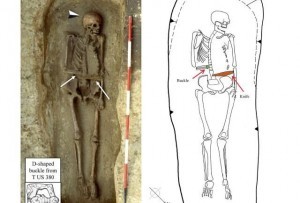In a discovery worthy of the Walking Dead, Italian archaeologists have identified a Medieval warrior whose right forearm and hand were amputated and who appears to have compensated with a knife-ended prosthesis.
The skeleton was found in Povegliano Veronese, a Longobard or early Medieval cemetery in northern Italy dating to the 6th-8th centuries AD. Numerous burials of adult men with weapons at their sides were discovered, along with a pit filled with a headless horse and two greyhounds. One man, however, clearly suffered a traumatic injury to his right forearm, and his case is reported in the most recent issue of the Journal of Anthropological Sciences by Ileana Micarelli and colleagues.
Researchers closely analyzed the bones and teeth of this older male adult, making a 3D model of his amputated right arm with a CT scan. They found that the amputation was the result of blunt force trauma to the forearm, but could not definitively conclude why it had been purposefully removed. “One possibility,” Micarelli and colleagues write, “is that the limb was amputated for medical reasons.” However, considering the Longobards were a warrior culture, “a loss due to fighting is also possible,” they suggest, or perhaps his arm was amputated “due to judicial punishment.”
Even more fascinating than the survival of this man in an era before antibiotics is the possibility he had a unique prosthesis. Micarelli and colleagues examined the ends of the man’s forearm bones and found that “there may have been a biomechanical force placed on the stump,” such as the pressure of the bones against a prosthesis.
Additional evidence for a prosthesis comes from the man’s teeth and shoulder. The teeth on the right side of his mouth were so severely worn down that he was suffering from an infection of his jaw bone. And his right shoulder joint, where his upper arm connected, was reoriented in an abnormal way. Both of these suggest that he was “tightening the prosthesis with his teeth.”
When the skeleton was first discovered in the early 1990s, archaeologists at the time found “a D-shaped buckle with decomposed organic material (most likely leather) surrounding it.” Across the man’s torso, just at the end of his right arm, lay a knife. The archaeologists’ conclusion: like Merle from the Walking Dead, this early Medieval warrior had a knife-hand prosthesis.
“The survival of this Longobard male testifies to community care, family compassion, and a high value given to human life,” the authors conclude. “Not only did he adjust very well to his condition, he did so with the use of a culturally-derived device, along with considerable community support.”
Source: forbes
Ask me anything
Explore related questions





